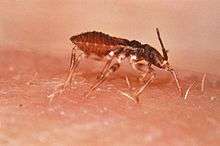Triatoma
| Triatoma | |
|---|---|
| | |
| (Left to right) Triatoma protracta, the most common species in the western U.S.; Triatoma gerstaeckeri, the most common species in Texas; Triatoma sanguisuga, the most common species in the eastern U.S. | |
| Scientific classification | |
| Kingdom: | Animalia |
| Phylum: | Arthropoda |
| Class: | Insecta |
| Order: | Hemiptera |
| Family: | Reduviidae |
| Subfamily: | Triatominae |
| Genus: | Triatoma Laporte, 1832 |
| Species | |
|
See text. | |
Triatoma is a genus of assassin bug in the subfamily Triatominae (kissing bugs). The members of Triatoma (like all members of Triatominae) are blood-sucking insects that can transmit serious diseases, such as Chagas disease. Their saliva may also trigger allergic reactions in sensitive individuals, up to and including severe anaphylactic shock.[1]
Species according to ECLAT
NOTE: The designation (Tc) signifies that the species is associated with Trypanosoma cruzi.
- T. amicitiae Lent, 1951b
- T. arthurneivai Lent & Martins, 1940 (Tc)
- T. baratai Carcavallo & Jurberg, 2000
- T. barberi Usinger, 1939 (Tc) [main vector in parts of central and southern Mexico].
- T. bolivari Carcavallo, Martínez & Peláez, 1987
- T. bouvieri Larrousse, 1924
- T. brailovskyi Martínez, Carcavallo & Peláez, 1984
- T. brasiliensis Neiva, 1911b (Tc) [main vector in the caatinga area of northeastern Brazil].
- T. breyeri Del Ponte, 1929
- T. carcavalloi Jurberg et al., 1998
- T. carrioni Larrousse, 1926 (Tc)
- T. cavernicola Else & Cheong, in Else et al.,1977
- T. circummaculata (Stal, 1859) (Tc)
- T. costalimai Verano & Galvão, 1958 (Tc)
- T. deaneorum Galvão, Souza & Lima, 1967
- T. delpontei Romaña & Abalos, 1947 (Tc)
- T. dimidiata (Latreille, 1811) (Tc) [important vector in parts of Mexico, Central America, Colombia and Ecuador].
- T. dispar Lent, 195 (Tc)
- T. dominicana Poinar 2005 (extinct, Eocene)
- T. eratyrusiformis Del Ponte, 1929 (Tc)
- T. garciabesi Carcavallo et al., 1967 (Tc)
- T. gerstaeckeri (Stal, 1859) (Tc).
- T. gomeznunezi Martinez, Carcavallo & Jurberg, 1994
- T. guasayana Wygodzinsky & Abalos, 1949 (Tc)
- T. guazu Lent & Wygodzinsky, 1979
- T. hegneri Mazzotti, 1940 (Tc)
- T. incrassata Usinger, 1939
- T. indictiva Neiva, 1912
- T. infestans (Klug, 1834) (Tc) [most important vector in southern cone countries].
- T. juazeirensis Costa & Felix, 2007 (Tc)
- T. jurbergi Carcavallo et al., 1998b
- T. klugi Carcavallo et al., 2001
- T. lecticularia (Stal, 1859) (Tc)
- T. lenti Sherlock & Serafim, 1967 (Tc)
- T. leopoldi (Schoudeten, 1933)
- T. limai Del Ponte, 1929
- T. maculata (Erichson, 1848) (Tc)
- T. matogrossensis Leite & Barbosa, 1953 (Tc)
- T. melanica Neiva & Lent, 1941 (Tc)
- T. melanocephala Neiva & Pinto, 1923b (Tc)
- T. mexicana (Herrich-Schaeffer, 1848)
- T. migrans Breddin, 1903
- T. neotomae Neiva, 1911d (Tc)
- T. nigromaculata (Stal, 1872) (Tc)
- T. nitida Usinger, 1939 (Tc)
- T. oliveirai (Neiva et al., 1939)
- T. patagonica Del Ponte, 1929 (Tc)
- T. peninsularis Usinger, 1940 (Tc)
- T. petrochiae Pinto & Barreto, 1925 (Tc)
- T. platensis Neiva, 1913 (Tc)
- T. protracta (Uhler, 1894) (Tc)
- T. pseudomaculata Correa & Espínola, 1964 (Tc)
- T. pugasi Lent, 1953b
- T. recurva (Stal, 1868) (Tc)
- T. rubida (Uhler, 1894) (Tc)
- T. rubrofasciata (De Geer, 1773) (Tc)
- T. rubrovaria (Blanchard, in Blanchard & Bulle, 1843) (Tc)
- T. ryckmani Zeledón & Ponce, 1972
- T. sanguisuga (Leconte, 1855) (Tc)
- T. sherlocki Ryckman, 1962
- T. sinaloensis Papa et al. 2002 (Tc)
- T. sinica Hsaio, 1965
- T. sordida (Stal, 1859) (Tc)
- T. tibiamaculata (Pinto, 1926b) (Tc)
- T. vandae Carcavallo et al. 2002
- T. venosa (Stal, 1872) (Tc)
- T. vitticeps (Stal, 1859) (Tc)
- T. williami Galvão, Souza & Lima, 1965 (Tc)
- T. wygodzinskyi Lent, 1951c
References
- ↑ "Triatomine Bug FAQs". Centers For Disease Control And Prevention: Parasites - American Trypanosomiasis (also known as Chagas Disease). 2016-09-07. Retrieved 2016-09-15.
Could I be allergic to the bite of a triatomine bug? -- Yes. The saliva of certain types of triatomines can cause an allergic reaction in some people. An allergic reaction may be characterized by severe redness, itching, swelling, welts, hives, or, rarely, anaphylactic shock (severe allergic reaction). ... It is important to note that not all triatomines are infected with the parasite even though they may cause an allergic reaction.
External links
- Information on Triatoma infestans and other members of Triatominae, by Andreas Rose
- ECLAT, European Community Latin American Network for Research on the Biology and Control of Triatominae
- more external links see: Triatominae
This article is issued from Wikipedia - version of the 9/15/2016. The text is available under the Creative Commons Attribution/Share Alike but additional terms may apply for the media files.
